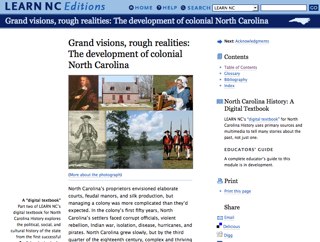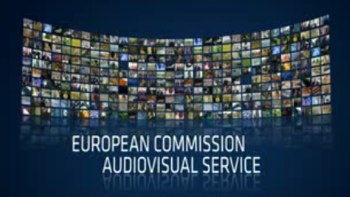I started a blog post a few weeks ago about digital textbooks, and some of the wiki projects and customizable digital textbook projects going on out there. Alas, I never got it finished and I’ve lost the notes now. But I was reminded of the topic when a MEGA mailing list message came across my inbox, announcing a new North Carolina History textbook — that’s digital. ((Ferris, Bill. “[MEGA] North Carolina History Digital textbook, Part 2 from LEARN NC.” E-mail to Author.20 Aug 2008. ))
 Developed by LEARN NC, a long-standing and consistent support agent for digital education in NC, Grand Visions, Rough Realities: The Development of Colonial North Carolina [flyer PDF, 95kb] is an web-based document that contains, among other things,
Developed by LEARN NC, a long-standing and consistent support agent for digital education in NC, Grand Visions, Rough Realities: The Development of Colonial North Carolina [flyer PDF, 95kb] is an web-based document that contains, among other things,
…67 pages of primary sources and background reading, plus guides for using the kinds of primary sources provided.
To collect content, LEARN NC worked with the North Carolina Office of Archives and History, the North Carolina Museum of History, UNC Libraries, Fort Dobbs State Historic Site, the North Carolina Literary Review, and other partners.
According to the e-mail, from Bill Ferris,
LEARN NC?s ?digital textbook? for 8th-grade North Carolina history provides a new model for teaching and learning. It makes primary sources central to the learning experience, using them to tell the stories of the past rather than merely illustrating it. Special web-based tools help students learn to read those sources and ask good questions of them. And because it?s on the web, this textbook relies on multimedia whenever possible to supplement or even replace text.
I found a chapter in the book about the German migration into North Carolina, a topic that I’ve not seen before in any NC History course I have taken. It was an interesting read for me, as my ancestors on my father’s side were part of the early 1700s immigration. I was intrigued by the circumstances in Europe, mostly religious wars, that forced so many German families to leave for the New World.
 With this still in my head this morning, I coincidentally ran across this video (Sharing the Sights and Sounds of Europe!) from the EU, through an unrelated recommendation that popped into my Twitter client. The YouTube video describe the Audiovisual Service of the European Commission, which appears to archive digital media related to a broad spectrum topics. The media is “free of charge / free of rights.”
With this still in my head this morning, I coincidentally ran across this video (Sharing the Sights and Sounds of Europe!) from the EU, through an unrelated recommendation that popped into my Twitter client. The YouTube video describe the Audiovisual Service of the European Commission, which appears to archive digital media related to a broad spectrum topics. The media is “free of charge / free of rights.”
Content can be found by search engine, thematic classification, or via the Europe by Satellite (EbS) service. Information is also streamed via vodcasting, podcasting, RSS feeds, and live and VOD streaming.
What got me thinking was a marriage of what LEARN NC is doing and a product like the Audiovisual Service, where the “textbook” arrives as an broad topic, multimedia encyclopedia that is not only searchable but also pluckable. Teachers and students might have a chapter described to them via discussion or presentation of a problem, and then work toward identifying content from the encyclopedia, assembling it into a personalized study resource gear not only toward the subject or problem, but also toward the individuals learning styles.
In a sense this would cause the traditional consumption approach to education and the emerging emphasis on production to overlap far more effectively than simply asking students to produce a multimedia presentation at the end of the chapter.
Here is the very funny video (Chemical Party) that actually connected me with the Audiovisual Service, suggested by Seesmic’s Loic Le Meur. It is designed to promote interest in science and chemistry, also from the European Commission.
